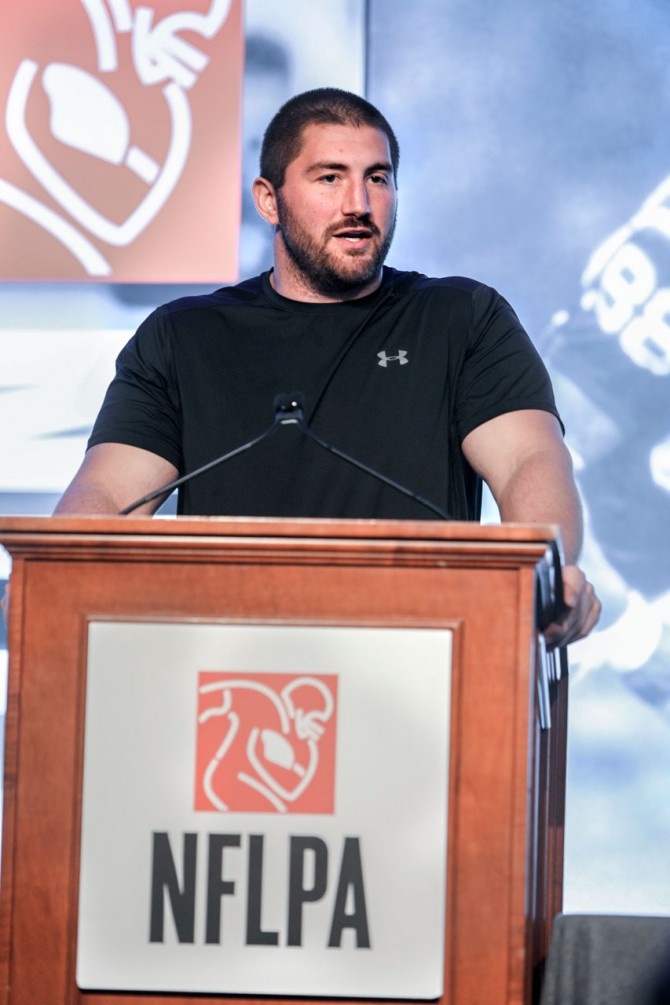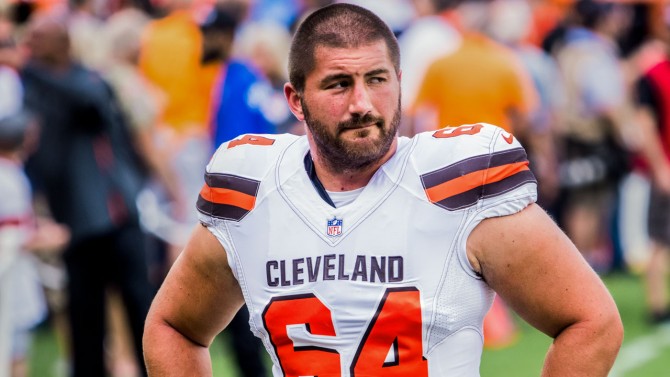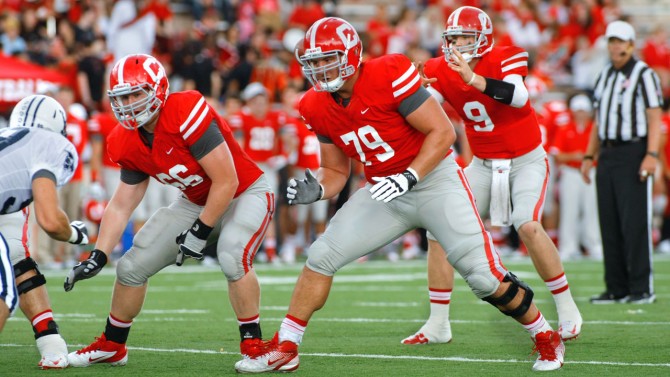
JC Tretter ’13, at the second day of training camp in July 2019, greets northeastern Ohio high school football players prior to the start of practice.
Leading from the center
Former Cornell football star JC Tretter ’13 elected to lead NFLPA
By Julie Greco
Since March, work life for JC Tretter ’13, a starting center for the National Football League’s Cleveland Browns, has become a lot more complicated.
On March 10, the eight-year NFL veteran was elected to represent all of the league’s players – and advocating for their wages, hours and working conditions – just five days before a vote on a controversial collective bargaining agreement that would set the course for NFL players for the next decade.
With the regular football season looming, now he’s tackling a bigger challenge: the COVID-19 pandemic.
As the newly elected president of the NFL Players Association (NFLPA), Tretter says the onus is on NFL owners to provide players with a safe work environment.
“The sport of football was almost made to transmit this virus. When you’re in the trenches, you are one foot away, face-to-face breathing on each other, which is literally the worst thing you can do with a virus,” Tretter says to Alex Colvin, Ph.D. ’99, the Kenneth F. Kahn ’69 Dean of the ILR School, in a recent episode of ILR’s podcast, WORK! Exploring the Future of Work, Labor and Employment. “(As an offensive lineman) there’s not a play where there’s not some sort of spit or breath on my face from somebody else. You do that 65 to 70 times a game. That’s a lot of exposure if that person’s sick.”
Add to that the garden-variety health issues that many players face. “People look at football players and athletes in general as these indestructible robots,” Tretter says. “We’re in some of the best shape in the world, but we have players with underlying conditions. We’ve got people with sleep apnea, asthma, high body mass index.”
Affiliated with the AFL-CIO and established in 1956, the NFLPA is the second-oldest labor union of the four major professional sports leagues. It has more than 10,000 active and former player members, and represents players’ interests during contract and other negotiations.
Tretter is well positioned for his new role thanks to his ILR School education, he says.
“My experience in the ILR School gave me both confidence and preparation for this position,” Tretter says. “One thing I really appreciate about my education was the focus on understanding all sides of an argument before drawing a conclusion. That approach helped me better evaluate the [collective bargaining] deal and our players’ varying perspectives toward it.”
The most recent contract was highly contested by the players each step of the way. After NFL owners approved the terms of the deal in February, the 11-member NFLPA executive committee voted 6-5 not to recommend the proposal. But the 32-player board of representatives voted by a slim 17-14 margin to send the deal to the union’s membership for a vote.
In the week before his election, Tretter attempted to educate his fellow players on the nuances of the 439-page agreement.
Tretter told The Buffalo News at the time: “I do think it is a truly important decision to make and it’s one that will have long-term impact on each individual in this game, as well as the game itself,” he said. “And I want each person to … make that decision based off what they feel is best for themselves and I don’t want to push them ‘yes,’ I don’t want to push them ‘no.’”
The players narrowly approved the new agreement, 1,019 to 959. The deal includes significant changes, including increasing the number of regular season games from 16 to 17, and expanding the playoff field from 12 teams to 14. As a trade-off for adding another week to the season, and the additional wear and tear that goes with it, rosters will increase, adding more opportunities for players to stay on a team through the practice squad. The deal also includes more money for players through revenue sharing, and increases salaries for rookies and players earning the league’s minimum salary.
“Going into the election, I felt confident that I’d be able to handle either outcome of the vote,” Tretter says. “Whether the contract was ratified or would’ve needed to be renegotiated, I was prepared to address those next steps.”
Tretter came to Cornell from Akron, New York, about 25 miles east of Buffalo. A two-sport athlete at Akron High School who played quarterback for the football team, he chose the ILR School because he wanted the flexibility to study what interested him most after completing core courses.
When he arrived on campus, Tretter was converted into a 238-pound tight end, who recorded five catches for 80 yards over his first two seasons. By the time he left Cornell, he was a 300-pound All-America left tackle, who went on to become the second Big Red football player to be taken in the NFL draft since 1997.
“We had a bunch of talented players on offense, but we struggled protecting the quarterback,” Tretter told Cornell students in 2016 during an ILR Sports Business Society event. “So, I wanted to help the team, and it became clear that it was the best chance that I had to play at the next level.”
David Archer ’05, the Roger J. Weiss ’61 Head Coach of Football at Cornell, says Tretter’s leadership talents were obvious during his Big Red days. “As an assistant coach when JC was a player, I observed his natural leadership abilities,” Archer says. “Even in college, he was a great liaison between the coaches and players, in addition to someone who set a very high bar for himself and his teammates.”
Tretter broke his nose while preparing for the NFL scouting combine and missed the opportunity to play in front of NFL scouts at the 2013 Senior Bowl. Even so, Green Bay selected him in the fourth round of the NFL draft.
More injuries followed. Tretter fractured his fibula and tore ligaments in his ankle during his first practice as a professional football player, resulting in the loss of his rookie season.
The injuries were a sign of things to come during his time in Green Bay, as he spent part of both the 2014 and 2016 seasons on the injured reserve list. He was signed to a free-agent deal by the Cleveland Browns before the 2017 season.
Since then, Tretter has been a dream come true for the Browns. He has started at center for the past three seasons and has served as the team’s union representative in each of the past two campaigns.
With the collective bargaining agreement behind him, Tretter is now working with NFL team owners and the NFLPA to ensure the players have the right to raise awareness for the causes they care about, such as the Black Lives Matter movement and other social justice issues.
“The first (role of the union) is to protect our players’ rights,” he says. “The next is to continue to work to provide opportunity for players to get involved and to promote their brands and their platforms. … I think players have really started to truly understand that they have a platform that they’ve earned through the work they’ve done in the football world.
“So don’t just stick to sports. Don’t just stick to football,” he counsels his fellow players. “Instead use that platform to branch out into other topics you’re passionate about and that you want to see changed in the world, and use your voice accordingly.”
This article is adapted from the original, which appeared in summer 2020 issue of ILRie Alumni Magazine.
Media Contact
Get Cornell news delivered right to your inbox.
Subscribe

